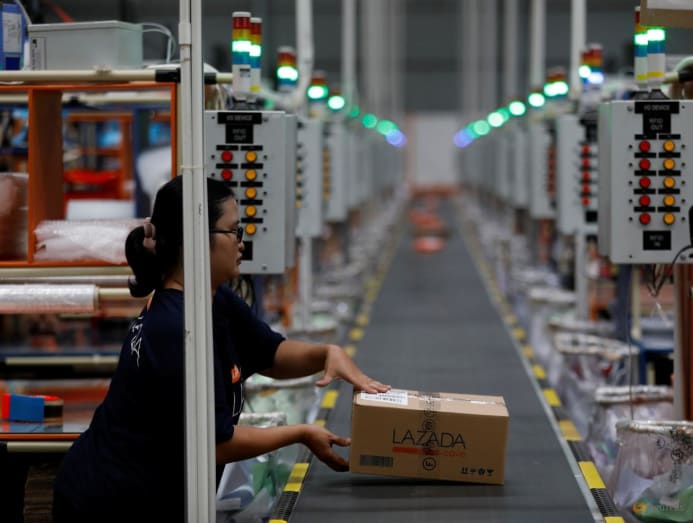The Big Read: E-commerce layoffs - heyday of online shopping could be over, with consumers on the losing end

(Illustration: TODAY/Nurjannah Suhaimi)

This audio is generated by an AI tool.
- Layoffs by e-commerce firms Lazada and Shopee in the last two years have led some to question whether the heyday of online shopping could be over
- Lazada had laid staff off to pre-empt future challenges such as a higher dependence on tech, and more complex marketing strategies
- Experts say, however, that the job cuts also signal an increased focus on making profits, rather than pursuing a ‘growth at all cost’ mindset
- They add that given the fast-changing nature of the industry and competition among the firms, a big player may eventually bow out
- Should that happen, then attractive discounts, low shipping costs that consumers enjoy now may be a thing of the past as competition dwindles
Some of the former employees’ concerns have since been addressed with the provision of an additional undisclosed support package following talks between Lazada and the workers' union.
But for several business analysts and industry experts whom TODAY spoke to, the Lazada move begs a bigger question: Could the heyday of e-commerce - which had experienced a surge during the COVID-19 pandemic - be over?
Prior to Lazada’s sudden layoffs, its main competitor Shopee had also conducted three rounds of layoffs in 2022, in which staff in Singapore were affected.
Experts have said that the pattern of layoffs from e-commerce firms echoes those by technology firms such as Meta, Google, Twitter (now X) and Grab, but Lazada, whose regional headquarters is in Singapore, has maintained that its situation is different.
A source close to Lazada told TODAY that these tech firms had perhaps overhired to gain market share, and retrenched when they had to focus on profits.
The source said that Lazada's layoffs are "a business transformation exercise".
"It is to get the whole company geared around two very core pillars that we are going to drive moving forward: Best price, and best customer experience."
While these pillars may be staples of the e-commerce business, there are "a whole lot" of mechanics, technology and know-how to deliver them, the source said.
She cited nascent technology, such as generative artificial intelligence (AI), leading to changes in the way a consumer’s experience on the Lazada application can be enhanced. To take advantage of this, some staff without the relevant skills had to be let go, but new staff with the relevant AI expertise may be hired.
"The whole transformation exercise is to refocus us to be agile, and streamline to delivering these two core pillars for the company," she said.
While adapting to new technologies and business strategies could lead to retrenchments, some experts pointed to another hard truth: Certain parts of the e-commerce business are no longer making profits or have been shown to be unprofitable, and so staff in those roles are laid off.
"There will of course always be pivots in technology and business concepts, such as today's current rush to embrace AI, but these likely affect only a small fraction of staff," said Associate Professor Walter Theseira, an economist from the Singapore University of Social Sciences (SUSS).
"Rather, the most likely explanation for the current wave of retrenchments is that too many tech firms have too many employees working in areas where firms and investors no longer believe there is a good return."

A DIFFERENT KIND OF TECH-STYLE RETRENCHMENT?
While e-commerce companies and tech firms, such as Google, Meta, X, and Grab, are involved in different businesses, they do have several similarities, said industry experts.
Most of these prominent tech firms have relied on some form of venture capital in order to be viable, said Dr Ng Weiyi, Assistant Professor from the Department of Strategy and Policy at the National University of Singapore (NUS) Business School.
Venture capital is money, technical, or managerial expertise provided by investors to startup firms which they perceive to have long-term growth potential.
Such venture capital values high risks and high returns, and typically focusses on growth and market leadership instead of profit and sustainability, said Dr Ng.
"If I invest a million dollars in you, I don’t want you to put it in a safe investment and give me 8 per cent per annum ... I rather you try and dominate the market, and grow," he said.
This is the case for e-commerce companies and the other tech firms, said Dr Ng, but the difference is that the tech firms have all already dominated their respective markets, while for e-commerce in Singapore and the Southeast Asian region, there is no obvious leader.
For instance, Google has dominated the search engine space and Meta the social media space with Instagram, WhatsApp, and Facebook. In Singapore, Grab has a predominant market share in the ride-hailing space.
However, the main e-commerce players in Southeast Asia and Singapore, Lazada and Shopee, are still jostling for a dominant market share.
"Similarly, the parent companies expect Shopee and Lazada to dominate the e-commerce landscape, but the fact is that the landscape as of now is still very fragmented and saturated," Dr Ng said.
There are no reliable publicly available figures on market share of the sector.
Another difference is that e-commerce firms have a less-robust revenue stream, while the other tech companies have either multiple or more reliable revenue streams.
Professor Lawrence Loh, director of the Centre for Governance and Sustainability at the National University of Singapore (NUS), said that for e-commerce firms, their ability to make money depends mostly on whether they generate enough demand from a "front-facing" customer.
This is despite the e-commerce industry having various revenue streams such as commission fees, advertising revenue, subscription fees from firms listing their products on the platform, and logistics fulfilment services.
But all these additional streams depend on sales it can generate from consumers, which has become more difficult post-COVID-19.
"Coming out of the pandemic, there’s a very obvious drop in demand for e-commerce, because people are showing up in brick-and-mortar shops again," said Prof Loh.
"The general economic environment is also not favourable, so disposable income is also less."
Tech firms, on the other hand, have more reliable sources of revenue.
Both Meta and Google, for instance, are making megabucks from advertisements.
For Grab, it generates revenues through multiple streams, including advertisements, ride-hailing and delivery fees, and transaction fees when payments are made through its e-wallet.
In addition, services like ride-hailing have seen an increase in demand post-COVID, thus generating a more robust revenue stream for Grab, given social interactions have returned to normalcy, said Prof Loh.
THE MIXED FORTUNES OF E-COMMERCE FIRMS
Lazada was established in Singapore in 2012, and by 2015, its gross merchandise value, or the total value of merchandise sold over a given period of time through customer-to-customer deals, had grown to over US$1.3 billion (S$1.75 billion), according to tech media platform KrAsia.
In April 2016, China’s largest e-commerce company, Alibaba, bought a majority stake in Lazada.
Shopee was first launched in Singapore in 2015, as a subsidiary company of Sea Limited. In 2018, Shopee went on "an offensive" where it began aggressively advertising throughout Southeast Asia to expand its market there, according to KrAsia.
Shopee’s advertising campaigns included international stars such as South Korean girl group Blackpink in 2018 and footballer Cristiano Ronaldo in 2019.
Shopee eventually pulled ahead of Lazada, which was mired by cultural conflicts and boardroom tussles, by the time the pandemic struck the region in 2020, according to a 2021 report by online publisher Asia Times.
In 2021, Shopee’s parent Sea was able to raise US$6 billion through an equity and convertible bond sale, the largest fundraising in Southeast Asia at that time.
However, Shopee’s fortunes soon changed. In 2022, less than a year after it had raised record funds, Sea cut more than 7,000 jobs in its offices in Indonesia, Thailand, Vietnam, China, and Singapore across three waves of retrenchments.
That year, Shopee also pulled out of markets it had expanded into, such as in France, Spain, India, Chile, Colombia, Mexico and Argentina. It also pulled out of Poland in 2023.
Then, in March 2023, Shopee laid off "fewer than 500" full-time and contract workers in Shopee’s customer service team in Indonesia, Bloomberg reported.

These measures helped Sea swing to a profit for 2023, its first annual profit since its initial public offering (IPO) in 2017.
An IPO is one of the methods that companies can use to go public, which will make its stock available to retail traders.
As for Lazada, its January 2024 retrenchment exercise came several months after Bloomberg reported in May 2023 that the e-commerce platform was exploring an IPO in the United States.
A smaller local player in Singapore's e-commerce scene is Ezbuy, which was founded here in 2010. According to business publication Vulcan Post, it was once dubbed as Singapore's largest global online shopping platform, connecting consumers to popular shopping sites like Taobao and Amazon.
However, it was in 2018 that signs of Ezbuy's decline began to show, with staff leaving the firm, as well as as frictions with other e-commerce firms and allegations of scalping.
From 2017 to 2021, Ezbuy's monthly web visits fell by over half, from 2.3 million to 1.07 million.
CHALLENGES THAT E-COMMERCE FIRMS FACE
According to Lazada, some of the challenges it had faced leading up to its retrenchment exercise - and will continue to face over the next few years - include fast-moving changes to technology and industry norms, as well as the demand patterns of its consumers.
"The industry itself is always changing, and it’s very fast in terms of the speed of change," said a Lazada spokesperson in response to queries from TODAY.
For instance, just five years ago, e-commerce was seen by consumers as more of a transactional space where they enter the application, make their purchases, and then leave.
The industry, however, has since employed different ways to keep users on the application; one such way being the inclusion of games on the Lazada app, where consumers can earn points and discounts.
"The company's innovative approaches to customer engagement have helped in customer loyalty and driving sales," said the Lazada spokesperson.
"Conventional forms of customer engagement that existed when Lazada first launched 12 years ago have now been replaced with creative gamification, which has been extremely successful with high usage rates in recent years."
TODAY had reached out to Shopee, which did not respond to queries.
The Lazada source who spoke to TODAY said that it had "done its best to support those with transferable skill sets to take on different roles or help workers with upskilling".
However, due to the fluidity of the e-commerce landscape, as well as fast-changing consumer needs and industry norms, some jobs had been lost across the e-commerce industry, the source said.
Agreeing with Lazada’s assessment, Dr Jeffrey Towson, managing partner at tech consultancy TechMoat Consulting, said that e-commerce trends move quickly and companies often have to scramble to capture the market. Such trends include live-streaming e-commerce, and mobile wallets and payments.
"The recent merger of video, commerce and social media into a new type of e-commerce means you need entirely new types of skills," said Dr Towson.
"Suddenly, you have to be an entertainment company, a retailer, and a logistics company."

HOW E-COMMERCE FIRMS MAKE MONEY
Unlike brick-and-mortar stores, e-commerce firms like Lazada do not usually have a warehouse of goods, and instead act as a middleman between sellers and firms, and the consumer, said Prof Loh from NUS.
Thus, according to business education blog FourWeekMBA, e-commerce firms generate revenue through several ways:
- The primary source of revenue is through commission fees from sellers for each successful sale made on the platform. According to Lazada’s website, it charges its Marketplace sellers a 2 per cent commission rate for successfully delivered orders. According to Shopee’s website, it charges its sellers a range of commission rates from 0 per cent to 4.24 per cent.
- Firms can also earn revenue through selling advertisement space on the platform
- They also earn fees through providing logistics services to sellers
- There are also other revenue streams such as through grocery deliveries, e-wallets transactions, and membership programmes
However, experts also noted that the challenges that most e-commerce firms have stem from the need to be profitable - gone are the days where companies are willing to splash money to gain market share.
"The investment thesis underlying much of the industry - especially in Asia - that firms needed to position themselves early, lose money to acquire market share, and then make it up later with dominant positions and economies of scale, appears to be failing," said SUSS’ Assoc Prof Theseira.
Agreeing, Dr Ng from NUS said that one of the reasons that venture capital is harder to come by is because of the high interest rate environment in the past few years, which has increased the cost of capital for such investments, making them less attractive.
Thus, the focus and challenge that many e-commerce firms now face is in making profit.
"I think this is the main reason why layoffs occur," said Assoc Prof Theseira. "No firm would need to lay off workers if nobody cared about profits ... Layoffs are all about improving the economic outcomes of the firm for investors and stakeholders."
The need for profitability also comes amid a time when the e-commerce space is getting more crowded with competitors.
"The competitive arena is now more intense, beyond Lazada and Shopee, now you have new kids on the block like Temu and Shein, and they bring new value propositions into the whole game," said Prof Loh from NUS. "(E-commerce firms) have to adjust their growth expectations accordingly."
Temu and Shein are online fashion brands from China.
On top of the rising cost of living, reducing consumers’ desire to spend, the e-commerce sector has also been hit by rising supply chain and shipping costs due to disruptions.
During the pandemic, sea freight rates surged to record highs. While the rates have dipped since, the ongoing Red Sea shipping crisis has caused rates to spike again.
"The cost of supply is getting high, (including) labour cost, material costs, because of inflation ... this adds to the pressure on the supplier and they will pass the costs back to the consumer," said Prof Loh.
Dr Ng added that even with higher shipping costs, e-commerce firms are still subsidising part or sometimes even all of the cost of shipping, especially for purchases above a certain amount.
"Since with higher purchases, the absolute margin is higher, so (e-commerce firms) can subsidise the logistics costs (given the) economies of scale," he said.
Furthermore, low shipping cost is a key factor why e-commerce appeals to consumers and online marketplace platforms will be wary of losing customers if they raise rates.

OVERCOMING CHALLENGES AMID FLUID LANDSCAPE
Despite the layoffs at the start of this year, Lazada’s business figures had been positive in 2023.
Speaking to TODAY, the source close to Lazada maintained that its retrenchment exercise was not due to the inability to generate revenue, but rather a shift to ensure it is "future-ready".
According to Alibaba’s (Lazada’s parent) report on its international e-commerce division, the subsection of international commerce retail, which Lazada falls under, had year-on-year growth of 60 per cent, 66 per cent and 62 per cent for the second, third and fourth quarter of 2023 respectively.
"The numbers have shown that there has been no slowdown, it has been growing," said the Lazada spokesperson.
The changes made in Lazada's workforce and job requirements speak to "the rapid evolution of the tech industry".
"Companies that do not keep up with the dynamic customer needs will be left behind and eventually must take drastic and costly measures to their business processes and workforce," the spokesperson said.
"Companies like Lazada, who continuously look to stay ahead of the curve, will have the leverage of agility to make minor but swift transformation changes required to ensure the company's long-term sustainable growth."
Experts noted that the manpower cuts are precisely the solution that e-commerce firms like Lazada would find useful heading into a future that prioritises long-term profit-making.
And it is usually the high-skilled manpower that is most affected by such cuts, said Assoc Prof Theseira.
"The catch with that high-skilled manpower is that firms realise they don't actually need everyone for the business to be delivered.
"If you take out one low skill, low tech worker, fewer parcels get delivered that day; if you take out a business development manager, you may not even notice any impact in the short term - and indeed, firms are betting exactly that," he said.

An article by the New York Times last month detailed how tech retrenchments have entered a "new phase" where firms are cutting workers despite being profitable.
This is a bid to "do more with less". In an environment where capital investments are harder to come by, it is up to the companies to cut staff and focus on fewer products to find a business model that works.
WILL CONSUMERS GAIN OR LOSE FROM HAVING ONE DOMINANT PLAYER?
However, despite signs that the e-commerce industry is beginning to generate sustainable revenues, experts are doubtful that the industry in the region will maintain its status quo in the near future.
The current state of competition in the e-commerce market in Southeast Asia will likely lead to a "lose-lose" situation for firms, said Prof Loh from NUS.
"There’s really so much (e-commerce firms) can do but to go low on prices," he said, noting that consumers are usually not loyal to any platform and thus will choose the one that offers the most attractive deals and lowest shipping costs.
"It’s a lose-lose for (the e-commerce firms)."
Agreeing, Dr Ng from NUS said that even amid a climate where profits are the priority, firms will be reluctant to cut back on offers and discounts as they will fear losing out to their competitors.
"It's a Catch-22, If I’m (an e-commerce firm) and I skip the next 3.3 sale, for example, and (a competitor) does not, while this might aid the bottom line in the near future, it will make me lose market share in the long term. Is this a good outcome?"
A "3.3" sale refers to specific sales events that occur on Mar 3, but can also occur on any date which the number of the day matches that of the month. It is typically chosen by e-commerce firms to offer discounts and attract new customers.
This is good news for consumers, said Dr Loh, as they will continue to enjoy low prices and deals at the expense of the e-commerce firms.
"Because of competition, prices will go down, and you might see many players being withered out of the game."
Indeed, due to the fierce competition that still rages in the e-commerce arena here and in the region, experts do not rule out a situation where one big e-commerce firm may bow out.
They pointed to a similar situation involving Grab and Uber in the 2010s. The ride-hailing firms were caught in a price battle after entering the Singapore market in 2013, offering various promotions and discounts for commuters and incentives for drivers.
However, Uber eventually decided to exit the Southeast Asian market, and sold its operations to Grab in 2018.
Should one e-commerce firm end up like Grab and become a dominant player in the industry, it is the customer that will lose out, said Dr Ng.
"The moment someone bows out, discounts stop ... This is a reflection of the venture capital strategy, the moment we dominate the market, we shift gears, focus on profitability, and stop subsidising the consumers."
Prof Loh added that having a dominant player would also mean that consumers have fewer varieties of online products to choose from, as more companies exit the market.
NOTES FOR E-COMMERCE EMPLOYEES, PAST AND PRESENT
Amid the disruptions in the sector, employees at e-commerce firms have to recognise that the industry moves quickly and that no job role should be taken for granted, said human resource (HR) experts.
Mr Adrian Tan, a workplace analyst with 21 years of experience, said that to preempt any potential retrenchment, it is up to employees to look into their firm’s revenue growth, and speak to those familiar with the company’s strategy to find out whether their jobs are at risk.
"Given today’s context, there is no more iron rice bowl, it is important for (employees) to have a finger on the pulse ... seek advice from others on how to interpret (company data) better and if it might have a material impact on their career."

While firms such as Lazada are doing their best to train their staff to adapt to new roles in the company in the event of a industry shift, Mr Tan said that there is no guarantee that a firm would want to invest in retraining an employee when it is more efficient to hire new talent with the required skills.
"We definitely would want to hear the narrative that company is family ... but when push comes to shove, your ‘family’ will have no qualms kicking you off the boat in order to make sure the boat can continue to float.
"It is still better to take ownership of your own training and development," Mr Tan said.
Agreeing, Ms Carmen Wee, founder of HR advisory firm Carmen Wee & Associates, said that it is important for prospective employees to have a "plan B" for their careers if they are looking to enter the e-commerce industry.
"You have to ask yourself, are you able and do you have the network in other industries to navigate to? The tech industry is quite big, so even if you lose your job in e-commerce, are you able to move to another tech firm?"
She added that even after landing a role, networking and upskilling within the role is essential.
For instance, if a worker were hired for their expertise in user experience, they should think about how this skill can be applicable to other industries and perhaps go for courses in their free time to ensure the skills are transferable.
"The ability to think beyond the short term is important, given that things are not as predictable as in the past," said Ms Wee.













